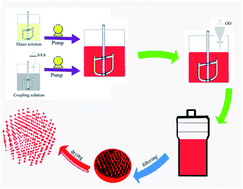Modification of C.I. Pigment Red 146 with surfactants and graphene oxide
Abstract
Organic pigments are important in a range of fields, from printing ink to industrial coatings. Azo pigments are some of the most common pigments in use today, but they typically have poor solvent solubility and tend to agglomerate. Consequently, the size and crystal structure of the pigment particles has a crucial effect on their optical and physical properties, such as color strength and solvent resistance, respectively. Several technologies, such as microreactors, have been developed to control pigment particle size, but an in-depth study of the effects of modification conditions on pigment properties (color, flowability, and solvent resistance) has not been reported to date. Therefore, in this paper, we report the surface modification of C.I. Pigment Red 146 particles using anionic (Igepon T) and non-ionic surfactants (Peregal O-25) and additives (DB-60 as the second diazo component and graphene oxide) on the pigment properties. In addition, we examined the effect of hydrothermal treatment at different temperatures on the same properties. The various modifications resulted in an increase in the solvent resistance, a reduction in the particle size (from 30.581 to 12.252 μm), a narrowing of the particle size distribution, and an increase in hydrophilicity. In addition, the color brightness and brilliance were significantly improved, and the maximum color strength reached 112.6%. These findings have applications for the development of pigments having enhanced color properties, solvent resistance, and processability.



 Please wait while we load your content...
Please wait while we load your content...